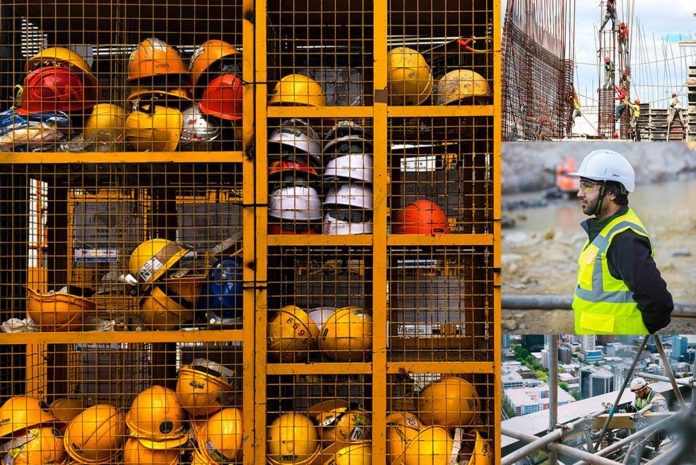Despite health and safety being a staple of every company’s policies and procedures, accidents and injuries at work are still commonplace. HSE (Health and Safety Executive) recently published the results of the annual labour force survey, which revealed that between 2017 and 2018, there were 555,000 injuries at work. 144 of them were fatal.
But what about industries that consider safety to be at the centre of their work?
As it stands, the construction industry contributes to a large number of recorded workplace injuries. In fact, HSE found that an estimated 58,000 cases of work-related injury occurred between 2017 and 2018. Around 2.6% of construction workers suffered an injury in this time, roughly 50% higher than the average of 1.8% across all industries.
Below, industry experts at Vizwear explore what it is that construction companies are doing wrong and how you can create a positive safety culture in your business.
How can poor health and safety affect your business?
Having a bad culture of health and safety hits your profits as hard as it does your reputation.
In the construction industry alone, around 2.4 million working days were lost between 2017 and 2018 due to workplace injury and illness. To put that statistic into perspective, that’s the equivalent of 10,000 construction workers being absent from work for a full year.
These absences add up to a staggering £1.06 billion loss, accounting for 7% of the total cost across all industries (£14.9 billion).
What are the signs of poor health and safety?
If you’re concerned that your own health and safety policies aren’t up to standard, there are a number of signs you can look out for:
● Poor accident reporting – If your team aren’t properly reporting and logging accidents in the workplace, then nothing can be done to prevent it from happening again in the future. Accident and injury books aren’t just for serious cases: they should be filled with any occurrences in the workplace. Your staff may not feel like their injuries aren’t worth the hassle, but the next time it happens, it could have more serious consequences.
● Blame culture – If your company blames individuals for injuries and relies on disciplining workers for accidents, you’re promoting a negative view of health and safety. You may be influencing employees to avoid correctly reporting incidents due to a fear of being reprimanded.
● Profitability over safety – When a company values profitability at a detriment to proper health and safety measures, its culture of site safety will inevitably suffer. This attitude will actually end up costing you more in the long run, as you’ll be forced to cover staff absences when accidents occur.
● Lack of communication – Without openly communicating the reasons behind new safety measures with your employees, you’ll create the impression that health and safety is an afterthought. Your staff won’t take policies seriously and you’ll make it difficult to establish a positive culture of site safety.
How to foster a culture of site safety
When it comes to creating a successful culture of site safety, it’s not as simple as creating new safety procedures and calling it a job well done – business leaders need to motivate their staff to take safety into their own hands.
Only by ensuring everyone buys into their own safety can management be confident that their staff are taking the right measures to cultivate a culture of site safety.
Here are a few small steps you can take to make sure your business is optimising its culture of safety:
1. Communicate
A lack of communication can hamper any attempts to develop your culture of workplace safety. Being open and honest with your employees about why new changes are being implemented at work is the easiest way to help them understand the necessity.
The more transparent you are as a manager, the more likely your staff will help health and safety updates run smoothly. However, it’s not just about communicating changes to your team: all current health and safety guidelines should be easily accessible to ensure everyone remains knowledgeable and up to date.
2. Mental health support
Construction workers have seen a serious problem with the condition of their mental health which has been a continuous issue for the industry over the years. Whether it’s depression, anxiety or stress, the industry suffered 14,000 cases between 2017 and 2018.
If you’re making strides to improve your culture of site safety, it’s crucial to work towards aiding your staff’s mental health. By providing further education and creating an environment that employees feel safe to open up and speak their mind, your workers will develop their own support system to protect each other’s mental health and wellbeing.
3. Lead by example
It goes without saying that if an employee knows that their manager doesn’t care whether health and safety procedures are followed, then they’re not going to follow them. This toxic behaviour will quickly disintegrate any attempt to create a culture of site safety.
When it comes to safety, you need to walk the walk. Show your team how important it is to adhere to safety standards by following them to the letter yourself. Your employees are far more likely to follow in your footsteps than to just take your word for it.
4. Training
Making sure your team is fully trained in site safety is crucial to ensure that workers are fully knowledgeable in safety procedures. With the correct training, you’ll have peace of mind that they know how to perform their jobs safely and correctly.
Review key training sessions and organise refresher courses often to reinforce key safety issues. With a fully trained team of safety experts at your disposal, your employees will be able to spot potential hazards before they become accidents.
5. Reporting
Of the estimated 58,000 workplace injuries between 2017 and 2018, only 4,919 were officially reported; meaning over 90% of non-fatal injuries were left unreported.
Reporting incidents shouldn’t be something that employees fear or feel uncomfortable doing. You need to make it clear to your employees that accident reporting isn’t an excuse to scold but rather to find out what caused an injury and what can be done to prevent it from happening in the future. By making proper reporting a core value of your worker’s job description, it will become like second nature to them.
Incentivising accident reports through prizes or monetary bonuses is a common action that managers take but the results may be counterintuitive. Safety incentive programs become routine and many employees become entitled; believing they deserve rewarding for carrying out their jobs.
Rather than trying to ‘buy’ your staff with incentives, allow them to set their own safety goals. Employees are more likely to respond positively to working towards their team’s own targets, rather than those set by executives who may be out of touch with their day-to-day operations.
6. Get the team involved
As site safety affects everyone, it’s only right that your employees should get to help shape your culture. The more you give your staff the opportunity to participate in safety initiatives, the more likely they are to adhere to precautions.
By running regular safety seminars, your team can voice their own safety concerns. This open style of contribution gives workers the chance to help implement safety changes that affect their own roles, making them much more likely to follow them and encourage others.
How to manage change
Now that you’ve got an idea of some of the ways you can change your businesses safety culture for the better, you can start implementing. However, it’s not just a case of putting on a training session and expecting to see results. To develop a genuinely progressive culture of site safety, you need to be always aware of what health and safety measures are in place and what needs to change.
Following the generic model of change, you can see how it relates to your business and how it refers to successful safety culture:
- Recognise the need for change – This is the moment you realise that your current health and safety standards aren’t cutting it and that improvements need to be made.
- Diagnose what needs to change – At this stage, you’ll pinpoint specifically which health and safety measures and issues are causing problems for your business.
- Plan for, and prepare to change – With your problems discovered, you’ll then design exactly what you need to do to improve and how you’ll do it.
- Implement the change – This is when all your planning and preparation comes into place and you put into place the solution to the problems you discovered.
- Sustain the change – Often neglected, this stage is one of the most important. This is where you need to ensure your initiatives are followed and the culture of site safety you’ve created remains at a high level.
Each stage of this model plays a vital role in developing your company’s culture, but the ability to recognise the need for change and sustaining change are the most crucial. With these two steps, you’ll always be aware of the safety standards in the workplace and will be striving to make sure current policies are followed.
“Health and safety in the construction industry isn’t something that can be ignored and picked up later,” says Daniel Ure from online PPE retailer Vizwear, “it’s a vital part of everyone’s day to day work.
“By keeping workers up to date with safety procedures, health and safety will become a natural part of their roles, rather than something they need to remember. When your staff become more aware, they’ll take fewer risks and make sure any accidents are logged: two simple ways that will keep everyone safer in the future.”




